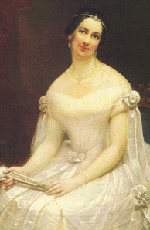|

Julia Gardiner Tyler
1820-1889
[John Tyler]
Biography: "I grieve my love a belle should be," sighed one of
Julia Gardiner's innumerable admirers in 1840; at the age of 20 she was already famous as
the "Rose of Long Island."
Daughter of Juliana McLachlan and David Gardiner, descendant of prominent
and wealthy New York families, Julia was trained from earliest childhood
for a life in society; she made her debut at 15. A European tour with
her family gave her new glimpses of social splendors. Late in 1842 the
Gardiners went to Washington for the winter social season, and Julia
became the undisputed darling of the capital. Her beauty and her
practiced charm attracted the most eminent men in the city, among them
President Tyler, a widower since September.
Tragedy brought his courtship poignant success the next winter. Julia,
her sister Margaret, and her father joined a Presidential excursion on
the new steam frigate Princeton; and David Gardiner lost his life
in the explosion of a huge naval gun. Tyler comforted Julia in her grief
and won her consent to a secret engagement.
The first President to marry in office took his vows in New York on June
26, 1844. The news was then broken to the American people, who greeted
it with keen interest, much publicity, and some criticism about the
couple's difference in age: 30 years.
As young Mrs. Tyler said herself, she "reigned" as First Lady for the
last eight months of her husband's term. Wearing white satin or black
lace to obey the conventions of mourning, she presided with vivacity and
animation at a series of parties. She enjoyed her position immensely,
and filled it with grace. For receptions she revived the formality of
the Van Buren administration; she welcomed guests with plumes in her
hair, attended by maids of honor dressed in white. She once declared,
with truth: "Nothing appears to delight the President more than...to
hear people sing my praises."
The Tylers' happiness was unshaken when they retired to their home at
Sherwood Forest in Virginia. There Julia bore five of her seven
children; and she acted as mistress of the plantation until the Civil
War. As such, she defended both states' rights and the institution of
slavery. She championed the political views of her husband, who remained
for her "the President" until the end of his life.
His death in 1862 came as a severe blow to her. In a poem composed for
his sixty-second birthday she had assured him that "what e'er changes
time may bring, I'll love thee as thou art!"
Even as a refugee in New York, she devoted herself to volunteer work for
the Confederacy. Its defeat found her impoverished. Not until 1958
would federal law provide automatic pensions for Presidential widows; but
Congress in 1870 voted a pension for Mary Lincoln, and Julia Tyler used
this precedent in seeking help. In December 1880 Congress voted her
$1,200 a year -- and after Garfield's assassination it passed bills to
grant uniform amounts of $5,000 annually to Mrs. Garfield, Mrs. Lincoln,
Mrs. Polk, and Mrs. Tyler. Living out her last years comfortably in
Richmond, Julia died there in 1889 an was buried there at her husband's side.



| 
